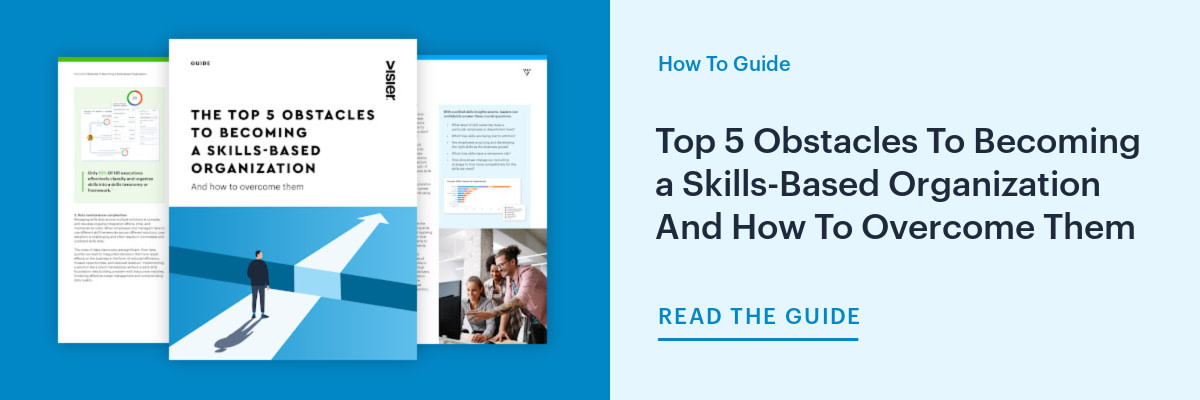What Is HR Transformation and How Does It Align With the Future of Work?
HR transformation helps to drive incremental change and improvements to the human resource and talent management function. Read to learn how to get started.

HR transformation may sound like a buzzword, but it is far from that—it is a necessity for any company that wants to remain competitive and successful. The past few years have brought unprecedented changes to the workplace. People’s priorities are shifting and so is the relationship between employer and employee.
The HR department can no longer be an afterthought. HR leaders are the ones who can drive positive change, help companies overcome labor shortages, create a skill-based approach to talent management, and more.
What is HR transformation?
HR transformation refers to the evolution of the human resources function and the process of reimagining and restructuring its role to make it more effective and strategic. It comes with an integration of technology, service delivery, and talent management to increase performance in all areas of the organization.
From the perspective of human resources leaders, HR transformation means evolving so that their roles are better aligned with the people, the business goals and strategies, and the technology with which they work.
Is HR transformation the solution to all your problems when it comes to talent management? It is not. Many professionals seem to think that if they revolutionize their HR department, if they introduce new software and even AI technologies, they’ll have a smooth journey with talent acquisition and retention, and their productivity will skyrocket.
Transforming the HR function, though, means more than simply introducing new technologies. It requires a complete shift in the methodology of talent management so that HR can have a more strategic approach to both talent and business.
True transformation, the type that can help you reach your goals, only happens when you start viewing human resources like a business partner.

What is an HR transformation strategy?
To make any real progress, you need a strategy, and HR transformation is no different. This strategy should be a comprehensive plan with goals and milestones to help you transform the HR function of your company.
You can’t just start adding technologies left and right and expect to see good results. The future of work is shifting and you must shift with it.
Start by assessing your current situation and see where there’s an opportunity for transformation. Look at what’s working and where there’s room for improvement and growth for the company, the employees, and the HR department alike.
The C-suite and key stakeholders from across the organization need to be involved in the HR transformation strategy. Chances are you’ll need to make investments. Whether that’s in new technologies or in training for the HR professionals, you’ll need everyone in the company on board.
What are the key drivers of HR transformation?
HR transformation is a team effort and its key drivers lie within the HR department. Many think of it as a complete change in how the human resources function looks and operates, but that doesn’t have to be the case.
HR transformation is first and foremost about evolution. It’s about aligning this function with your people's needs and strategies. With that in mind, there are four important drivers in this process.
1. HR leadership
CHROs set the tone for the HR department. They are also the ones in a position to influence decisions within the company by providing inputs on important business strategy decisions. They can optimize the budget and distribute leadership among their direct reports.
In short, human resources leadership is in the perfect position to drive true HR transformation beyond adopting new technology or creating new roles.
2. HR operating model
The operating model is the foundational piece in HR transformation. It defines how the HR function works, how the teams are organized, what their respective responsibilities are, and more.
When the HR department’s operating model is transformed, the result is more robust operations and a pool of problem solvers that can support thought leadership.

3. HR capabilities and competencies
Workforce needs are evolving rapidly, and HR capabilities must evolve as well. Ensuring your human resources department has all the competencies needed to address these changes is crucial.
HR needs to adapt to new ways of approaching the workforce and business in general. They need to be problem-solvers that can connect well with employees and leaders to find the right answers at the right time.
4. HR technology enablement
Adopting the right technologies is a central part of HR transformation. With hybrid and remote work being a top priority for many employees, HR needs to adopt tools and processes that facilitate a strong employee experience for everyone.
Whether that is artificial intelligence, machine learning, people analytics, or other tools, the focus should be on solutions that can make an immediate positive impact. The key is to turn data into actionable insights and identify skill gaps, the potential for growth, and more.
4 steps to maximize the success of your HR transformation
Successful HR transformation requires careful planning, the support of the entire company, and ongoing observation. Here are a few steps to help you on your journey.
1. Get everyone on board
Your HR department is critical for the success of the organization. So it should come as no surprise that everyone needs to be on board with the transformation efforts.
Managers and leaders must be involved in crafting the perfect transformation strategy. Encourage them to share their thoughts and ideas and incorporate their insights into your plan. This will ensure the HR transformation goals are aligned with the goals and priorities of the company and will increase the chances of success.
Don’t forget about the rest of your employees, either. The work that human resources does impacts everyone—from the moment they enter the company until they leave. Employees may not be directly involved in the decision-making process, but that doesn’t mean their opinion doesn’t matter.
Communicate your plan in a way that’s easy to understand for everyone. Make sure a majority of your workforce is on board, that they see the value of the transformation you’re planning, and that there are no pressing worries to address.
2. Assess your needs, set goals, and create a plan
Start by looking at the current state of the HR function in your company. You can look at metrics, surveys, compare market data, and more. The goal here is to get a clear vision of what you’re trying to achieve, why you want to transform the HR function in your company, and how.
Next, create a plan that will turn your needs and goals into actionable steps. Make it detailed and include step-by-step guides to make sure everyone knows what they need to do and when. Include any tools and processes you’ll be using and make it clear who will be responsible for each step.
Don’t forget your HR efforts need to include people data. Incorporating people analytics into your plan will help turn that data into actionable insights and show you all the opportunities for growth.

3. Choose the right technology
Technology plays a huge role in HR transformation, so choosing the correct tools is imperative. You shouldn’t use digitalization as a metric, but rather as a means to achieve your goals.
Do you want to automate manual data processes? Or perhaps you’d like to use AI to improve the employee experience? Maybe you need to give HR more tools to help them work on diversity and inclusion.
Keep going back to the “why”. Why do you want to transform the HR function? What are the goals? The answer will point you in the right direction and help you choose smart technology solutions.
4. Invest in learning and development solutions for the HR department
HR transformation is not only about getting new technologies and letting people figure out what to do with them. You’ll need to invest in a learning & development plan to help those working in HR improve their skills and grow. You can’t have true transformation if the people doing the work are stagnant.
5. Track progress
Your goals should provide an easy way to track progress. Analyze metrics and gather feedback from stakeholders, employees, and CHROs alike.
Do stakeholders and those in leadership positions feel like the transformation is reaching its goals and helping the company?
Are employees feeling a positive impact or are they, on the contrary, dissatisfied with the changes?
What about HR leaders? Do they feel their work is improving? Are the new technologies truly helping, boosting productivity or are they more of a nuisance?
Evaluate the progress from every angle and make adjustments where needed.
HR transformation is inevitable and necessary. The only question is whether companies will be able to take full advantage of its potential beyond acquiring some new technologies.
On the Outsmart blog, we write about workforce-related topics like what makes a good manager, how to reduce employee turnover, and reskilling employees. We also report on trending topics like ESG and EU CSRD requirements and preparing for a recession, and advise on HR best practices like how to create a strategic compensation strategy, metrics every CHRO should track, and connecting people data to business data. But if you really want to know the bread and butter of Visier, read our post about the benefits of people analytics.



